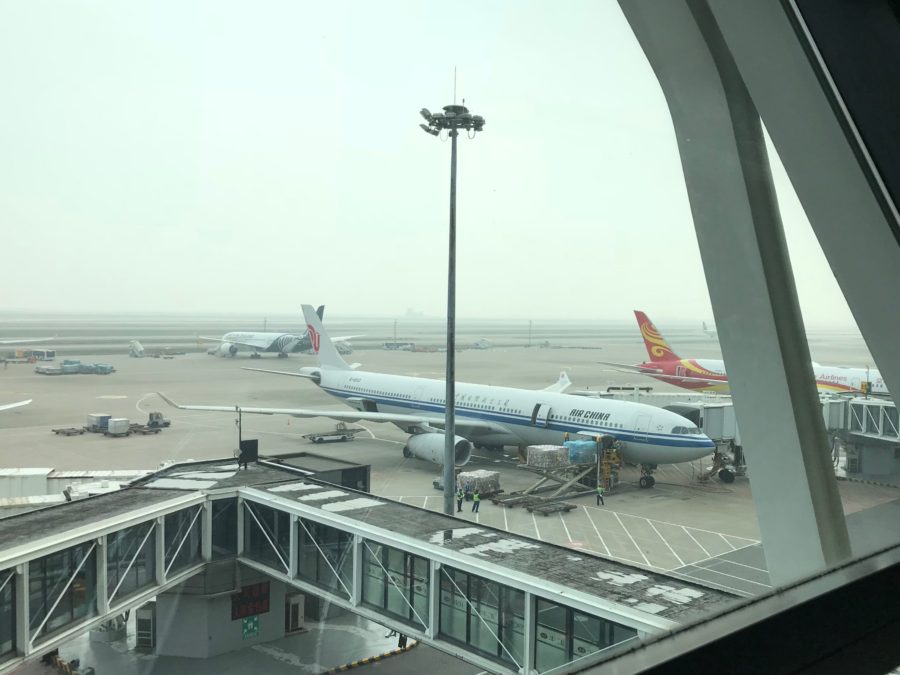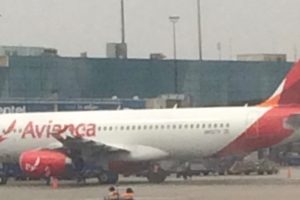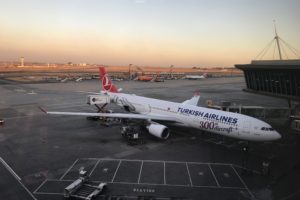Airline Profile: Air China
The Facts:
| Alliance | Star Alliance |
| Competitors | China Eastern Airlines China Southern Airlines Hainan Airlines Sichuan Airlines Xiamen Air |
| Fleet Count | About 429 |
| Founded | 1988 |
| Frequent Flyer Program | PhoenixMiles |
| Headquarters | Beijing, China |
| Hubs | Beijing Capital International Airport Chengdu Shuangliu InternationalAirport Shanghai Pudong International Airport |
| Parent Company | Air China Group |
| Skytrax Rating | 3 (out of 5) |
| Subsidiaries | Air China Cargo Air Macau Dalian Airlines Shenzhen Airlines Shandong Airlines Tibet Airlines |
| Travel Classes | Economy Class Premium Economy Class Business Class First Class |
| Type of Airline | Full Service |
| Website |

Analysis:
4 Things You Need To Know About Air China
- North American Flights: Air China flies to 9 destinations nonstop in North America from a couple of destinations in China (but mostly only Beijing). Their North American destinations include Los Angeles (2x daily 777-300 from Beijing, 3x weekly 787-9 from Shenzhen), San Francisco (1-2x daily 777/747 from Beijing), Houston (4x weekly 777 from Beijing), Washington Dulles (daily 777 from Beijing), Newark (daily 777 from Beijing), New York JFK (2x daily 777/747 from Beijing), Montreal (6x weekly 787 from Beijing), and Vancouver (1-2x daily 777/A330 from Beijing), and Honolulu (to be discontinued, 3x weekly A330 from Beijing). In addition to the 9 nonstop destinations to North America from China, they also operate two fifth freedom routes to two more destinations in North America: 1x weekly via Montreal to Havana and 2x weekly via Houston to Panama City.
- Route Network: Air China is one of the few airlines that serve all six inhabited continents. In fact, they are the only airline from Asia to serve South America with their flight to Sao Paulo, although it does stop via Madrid and is one of the world’s longest direct (not nonstop) flights. They also only serve one destination in Africa (Johannesburg) from Beijing via Shenzhen. Because of China’s one-airline-per-international-route policy (I call it the aviation equivalent of the one-child policy), Air China has most of its international routes out of one hub: Beijing. They also operate a few long-haul routes from a few other (non-hub) cities in China to intercontinental destinations, such as their route from Hangzhou to Rome or from Munich to Shenzhen which is indirectly the result of the one airline per international route policy.
- Fleet: Air China has a mixed fleet of both Airbus and Boeing aircraft. They operate the Airbus A319, A320, A321 (and the neo variants of all three types), 737-700, 737-800, and the 737 MAX 8 (now grounded) in their short-haul fleet. In their long-haul fleet, they operate nearly 60 Airbus A330s (both the -200 and -300, making it one of the largest operators of the type), 10 A350s with another 20 on order (only aircraft with their new business class seats), almost 30 777-300ERs, 15 787-9s, 7 Boeing 747-8s (they are one of three commercial operators), and 3 Boeing 747-400s used for domestic and government transport. Lastly, they also have 20 Comac C919s, a Chinese narrow-body aircraft similar to the A320, on order.
- Subsidiaries: Air China (which is majority-owned by the Chinese Government) is the third-largest Chinese airline and has multiple Chinese subsidiaries, each of which focuses on different markets (and has different hub cities) within China. The largest airline subsidiary is Shenzhen Airlines (which actually itself is also in Star Alliance) and flies mostly out of (you guessed it!) Shenzhen to numerous destinations around Asia and to London. Their second largest subsidiary, Shandong Airlines only flies short-haul aircraft, mostly out of Jinan and Qingdao. Lastly, Air China also owns three smaller, mostly regional subsidiaries which include Air Macau (the largest airline out of Macau), Dalian Airlines (which, as you might have guessed has its hub in Dalian), and Tibet Airlines (which is one of the few airlines that serves Tibet).
Travel Classes:
Economy Class
Economy Class on Air China is in a 3-3 configuration on all Airbus A320 series and Boeing 737 aircraft, a 2-4-2 configuration on all Airbus A330 series aircraft, a 3-3-3 configuration on all Airbus A350s, Boeing 777-300ERs, and Boeing 787-9s, and is in a 3-4-3 configuration on all Boeing 747s. Air China is a bit ambiguous as to which aircraft offer in-flight entertainment, although from what I’ve found, all Boeing 777s, 747s, 787s, and Airbus A330-200s and some A330-300s feature personal on-demand (seat-back screens) entertainment in economy class. However, all narrow-body aircraft and some older Airbus A330-300s don’t feature in-flight entertainment – it really wouldn’t be nice to be on one of their A330-300s that flies on some of their longest routes without any in-flight entertainment at all. However, power outlets are available in economy class on all of their 747-8s, 777s, 787s, and some Airbus A330s although aren’t on any of their short-haul aircraft.
Air China has pretty good legroom with an average seat pitch of about 32 inches on long-haul aircraft and an average of 31 inches on short-haul aircraft. Air China, being a full-service carrier, serves full meals in economy class on most flights besides regional ones. Passengers in economy class on Air China are permitted to carry one 5kg (11lbs) carry-on bag on board the aircraft and can check one 23kg (50lbs) bag on each flight. WiFi is available for purchase on select aircraft, including some Airbus A330-200s, A330-300s, A350-900s, and Boeing 777-300ERs.
Premium Economy
Air China has two vastly different premium economy products on most of its long-haul aircraft. It is featured on all of its A330-300s, 747-8s, 787-9s, and A350-900s. On its A330-300s, 747-8s, and 787-9s, premium economy is more of an extra-legroom economy class product (think economy plus), with the same seats as economy class just with a little bit of extra recline and legroom. However, on their A350s which they recently introduced, Air China has regular premium economy seats with extra legroom, leg rests, wider seats, and much more recline than in economy class. Their A350 premium economy product uses the same seats that United, Delta, and American do in their premium economy products and is similar to short-haul business class seats. So there is a lot of variance between premium economy products. Overall, if paying for premium economy, you’ll definitely want to fly on their A350 as their other aircraft with it more or less just have an economy plus product selling as premium economy.

Air China doesn’t publish a lot of information on their website about what you can find onboard the aircraft, although from what I’ve found, they get slippers, blankets, pillows (possibly better than what is found in economy), water bottles, and possibly better food. Another difference between economy class and premium economy is that on some of Air China’s older A330-300s which don’t have in-flight entertainment in economy class,
Business Class
Business class is featured onboard all Air China aircraft and has multiple seats, which are listed at the end of the business class section. On long-haul flights, passengers are provided with a pillow, blanket (but no mattress pads), a standard amenity kit, slippers, and headphones. Air China also allows business class passengers to pre-order meals on long-haul flights, although they can also order the standard business class meals onboard. Passengers traveling in business class have access to Air China business class lounges, Star Alliance Gold lounges, or partnering lounges at select airports. Business-class passengers can also check two 32kg (70lbs) bags on international flights. On domestic flights, business class is labeled as First Class, which can be somewhat confusing. Air China has multiple business class seats on its aircraft, which are described below from worst to best. Please note that Air China also has angle-flat seats on its two 747-400s, although I’m not listing it below since the product is only featured on two aircraft which will soon be retired.
- Recliner: Air China has recliner seats on all of its short-haul aircraft, which include the A319, A320, A321, 737-700, and the 737-800. These seats are similar to US domestic first-class seats. That means that the seats are wider and more comfortable than in economy class and have more recline, although Air China also has leg rests and footrests on its short-haul business class. The seats are in a 2-2 configuration on all A320 and 737 series aircraft. Unfortunately, Air China’s short-haul business class does not have any form of in-flight entertainment besides overhead screens playing videos. However, most of its short-haul business class seats do have power outlets.
- Rockwell Collins Parallel Diamond: Air China uses the Rockwell Collins Parallel Diamond seat on all of its Boeing 777-300ERs and Boeing 747-8 aircraft. The Parallel Diamond seat is very common among airlines, most prominently among United which uses it on most of its 767s, 757s, 787s, and some 777s. Other airlines that use the seat include Qatar Airways (A330s), Ethiopian Airlines (A350s, 787s), EVA Air (A330), and Royal Jordanian (787). The seats themselves transform into fully flat seats parallel to the ground. They are in a 2-2-2 configuration on the 777 and 747 (lower deck) and in a 2-2 configuration on the 747 (upper deck, nose). However, they are one of the most compact lie-flat seats on the market which means that the seats don’t have much privacy or storage and have really tight footwells. They also have personal on-demand entertainment and power outlets. These seats are perfectly fine for medium-haul routes, although one would expect seats with all aisle access on some of the long-haul flights that they are used on to Europe and North America.
- Zodiac Aura: All of Air China’s Airbus A330s (both the -200 and -300 model) use the Zodiac Aura seat. The seat is a little bit similar to the Parallel Diamond seat in the way that they don’t have all aisle access, as the seats are also in a 2-2-2 configuration. The seats also fully lie flat and horizontal. They are debatably better than the Parallel Diamond seats, mostly because they don’t have the restrictive footwells that the Diamond seats have and they have a bit more storage. However, they do have even less privacy than the Diamond seats and you still need to climb over a neighbor to reach the aisle if you are in a window seat. The seats do have personal on-demand entertainment and power outlets.

- Rockwell Collins Super Diamond: Air China introduced a new business class product with the introduction of its A350-900s. All of their A350s have the Super Diamond seat which is reverse herringbone seats and are in a 1-2-1 configuration. The seats are debatably the best off-the-shelf business class product out there. Therefore, they have all aisle access and are by far the best business class seat of Air China’s. They also have significantly more storage and privacy than Air China’s other business class seats in addition to also having power outlets and personal on-demand in-flight entertainment. If possible, do everything you can to get on Air China’s A350 in business class as they have much better seats than their other aircraft.


First Class
First Class is available on some of Air China’s Boeing 777-300ERs and on some of their Boeing 747-8s. First class features open suites in a 1-2-1 configuration on both aircraft. In a day where many business class cabins have closed suites with doors, it simply isn’t acceptable to have a first class cabin without doors, however the seats do have quite a bit of privacy and storage themselves. Passengers in first class also get better service and food than in business class and receive pajamas, better amenity kits, mattress pads, and better bedding. First class passengers also have access to the Air China first class lounges, which aren’t that much better than their business class lounge, along with other Star Alliance Gold and partnering lounges. First Class passengers can check two 32kg (70lbs) bags on all international flights. Please note that on domestic flights, First Class is branded as First Luxury.




